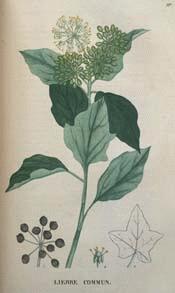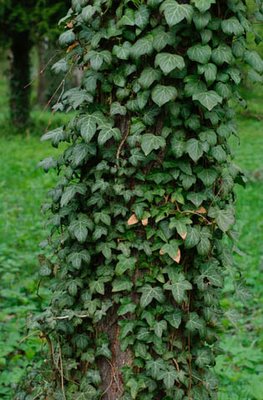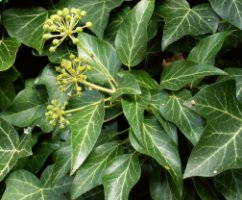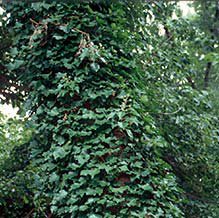Hedera helix (ivy)
I also would like to revise English vocabulary.
Hedera helix (Ivy)

DESCRIPTION:
English ivy is an evergreen climbing vine. Vines attach to the bark of trees, brickwork, and other surfaces by way of numerous, small rootlike structures, which exude a gluelike substance. Older vines are known to reach a foot in diameter. Leaves are dark green, waxy, somewhat leathery, and are arranged alternately along the stem. English ivy has many recognized leaf forms, the most common being a 3-lobed leaf with a heart-shaped base. Leaves in full sun are often unlobed, oval and have wedge-shaped bases. Umbrella-like clusters of small, greenish-white flowers appear in the fall if sufficient sunlight is available. Fruits mature in Spring and are black with a fleshy outer covering enclosing one to a few hard, stone-like seeds.
Compounds in English ivy are somewhat toxic and include glycosides that cause vomiting, diarrhea, nervous conditions and dermatitis in sensitive individuals. This characteristic helps ensure spread of the seeds by many native songbirds that are attracted to the black berries in Spring when other food sources are limited.
Habitat
The plant is found over the greater part of Europe and Northern and Central Asia, and is said to have been particularly abundant at Nyssa, the fabled home of Bacchus in his youth. There are many varieties, but only two accepted species, i.e. Hedera Helix and the Australian species, which is confined to the southern Continent.
Some more info about Ivy
When it attains the summit of a tree or wall, it grows out in a bushy form, and the leaves instead of being five-lobed and angular, as they are below, become ovate, with entire margins. Ivy only produces flowers when the branches get above their support, the flowering branches being bushy and projecting a foot or two from the climbing stems, with flowers at the end of every shoot.
- Professor Henslow has an interesting note on the Ivy and its shoots, in his Floral Ramblesin Highways and Byways:
- 'The shoots turn to the darker side, as may be seen when Ivy reaches the top of a wall, from both sides; wherever the sun may be the shoots lie flat upon the top. The roots themselves only come out from the darker side of the shoots, so that both of these acquired habits have their purposes. When the Ivy is going to flower, the shoots now turn to the light and stand out freely into the air; moreover the form of the leaf changes from a finepointed one to a much smaller oval type. As the shoot now has to support itself, if a section be made and compared with one of the same diameter which is supported by the adhesive roots, it will be found that it has put on more wood with less pith, than in that of the supported stem. It at once, so to speak, feels the strain and makes wood sufficient to meet it.'
The flowers of Common Ivy are small, in clusters of nearly globular umbels and of a yellowish-green, with five broad and short petals and five stamens. They seldom open before the latter end of October, and often continue to expand till late in December. Though they have little or no scent, they yield abundance of nectar and afford food to bees late in the autumn, when they can get no other.
The berries, which do not become ripe till the following spring, provide many birds, especially wood pigeons, thrushes and blackbirds with food during severe winters. When ripe, they are about the size of a pea, black or deep purple, smooth and succulent, and contain two to five seeds. They have a bitter and nauseous taste, and when rubbed, an aromatic and slightly resinous odour.
Ivy was in high esteem among the ancients. Its leaves formed the poet's crown, as well as the wreath of Bacchus, to whom the plant was dedicated, probably because of the practice of binding the brow with Ivy leaves to prevent intoxication, a quality formerly attributed to the plant. We are told by old writers that the effects of intoxication by wine are removed if a handful of Ivy leaves are bruised and gently boiled in wine and drunk.
It is the Common Ivy that is alluded to in the Idylls of Theocritus, but the Golden Ivy of Virgil is supposed to be the yellowberried variety (Hedera Chrysocarpa), now so rare.
The Greek priests presented a wreath of Ivy to newly-married persons, and the Ivy has throughout the ages been regarded as the emblem of fidelity. The custom of decorating houses and churches with Ivy at Christmas was forbidden by one of the early Councils of the Church, on account of its pagan associations, but the custom still remains.
An Ivy leaf is the badge of the Gordons.
The Roman agricultural writers much recommended Ivy leaves as cattle food, but they are not relished by cows, though sheep and deer will sometimes eat them in the winter. The broad leaves being evergreen afford shelter to birds in the winter, and many prefer Ivy to other shrubs, in which to build their nests.
The wood when it attains a sufficient size is employed by turners in Southern Europe, but being very soft is seldom used in England except for whetting the knives of leatherdressers. It is very porous, and the ancients thought it had the property of separating wine from water by filtration, an error arising from the fact that wood absorbs the colour of the liquid in its passage through the pores. On the Continent it has sometimes been used in thin slices as a filter.
In former days, English taverns bore over their doors the sign of an Ivy bush, to indicate the excellence of the liquor supplied within: hence the saying 'Good wine needs no bush.'
The medicinal virtues of Ivy are little regarded nowadays. Its great value is as an ornamental covering for unsightly buildings and it is said to be the only plant which does not make walls damp. It acts as a curtain, the leaves from the way they fall, forming a sort of armour and holding and absorbing the rain and moisture.
Ivy is very hardy; not only are the leaves seldom injured by frost, but they suffer little from smoke, or from the vitiated air of manufacturing towns. The plant lives to a great age, its stems become woody and often attain a considerable size - Ivy trunks of a foot in diameter are often to be seen where the plant has for many years climbed undisturbed over rocks and ruins.
The spring months are the best times for planting.
Robinson tells us that a drachm of the flowers decocted in wine restrains dysentery, and that the yellow berries are good for those who spit blood and against the jaundice.
Culpepper says of the Ivy: 'It is an enemy to the nerves and sinews taken inwardly, but most excellent outwardly.'
To remove sunburn it is recommended to smear the face with tender Ivy twigs boiled in butter; according to the old English Leechbook of Bald.




0 Comments:
Post a Comment
<< Home